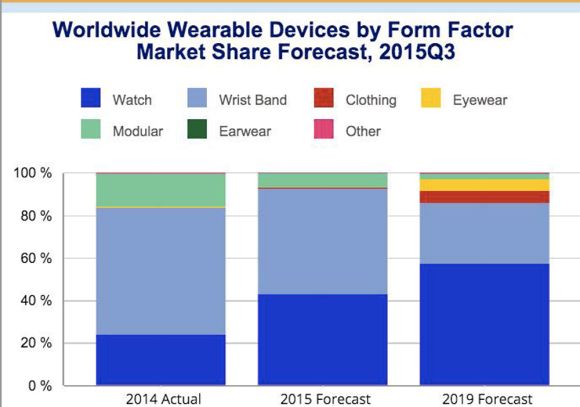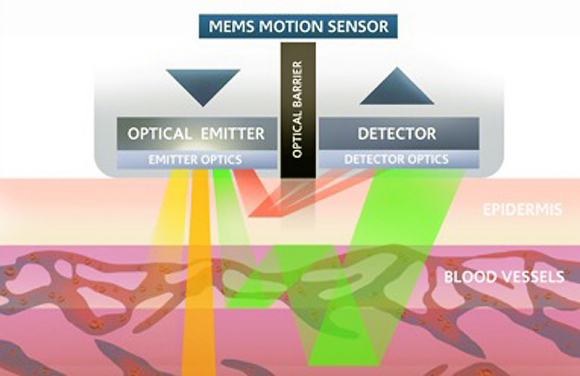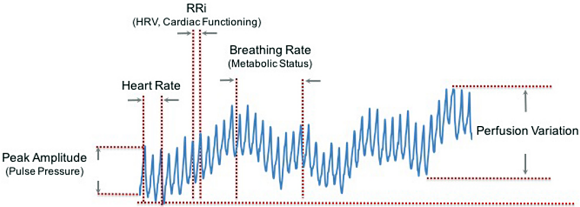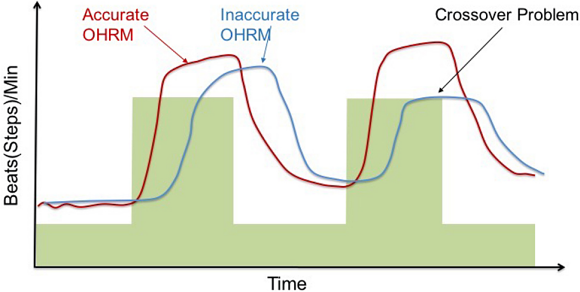
Wearable Stats
The market for wearable devices of all shapes and sizes is growing extremely quickly and that growth does not appear to be slowing down. According to IDC, "The worldwide wearable device market will reach a total of 111.1 million units shipped in 2016, up a strong 44.4% from the 80 million units expected to ship shipped in 2015. By 2019, the final year of the forecast, total shipments will reach 214.6 million units, resulting in a five-year compound annual growth rate (CAGR) of 28%." (see figure 1)

Fig. 1: Worldwide wearable device market will reach a total of 111.1 million units shipped in 2016.
Almost all next generation wearables are incorporating biometric sensors into the devices to provide more advanced insights into activity and overall personal health. The most common biometric sensor in wearables is an optical heart rate monitor (OHRM). OHRM's use a process called photoplethysmography (PPG), which involves shining light into the skin and measuring perfusion of blood in the dermis and subcutaneous tissue by capturing the different amounts light refracted by varying volumes of blood flow that occur when the heart pumps (see figure 2).

Fig. 2: Photoplethysmography (PPG) involves shining light into the skin and measuring perfusion of blood in the dermis and subcutaneous tissue.
Next, signal-processing algorithms process the data coming off the sensors to turn that raw data into usable metrics like heart rate, breathing rate, blood pressure, and many more (see figure 3).

Fig.3: Signal-processing algorithms handle the data coming off wearable sensors.
However, most products currently on the market do not perform as well as a chest strap, widely considered the benchmark for personal heart-rate measurement, particularly during motion and activities such as running, lifting weights, and even during simple daily activities such as typing and washing dishes.
Measuring heart rate during activity is extremely difficult to do because it must work accurately across such a wide range of variables – different activities, body movements, body types, and wearable-device form factors, i.e., smartwatches, earbuds, wristbands, etc.
While each device and use case has its own challenges, there are five foundational challenges that impact the accuracy of OHRMs today:
- Optical Noise
- Sensor Location on the Body
- Skin Tone
- The Crossover Problem
- Low Perfusion
Let's explore each of these in more detail.
Next page
Optical Noise
The biggest technical hurdle facing digital signal processing of PPG signals is separating the biometric signal from the noise, especially motion noise. Unfortunately, when you shine light into a person's skin, only a small fraction of photons return to the sensor. And of the total photons collected, only 1/100th or 1/1,000th of them are modulated by heart-pumped blood flow. The rest of the photons are simply scattered from non-pulsatile physiological material, such as skin, muscle, tendons, etc. Thus, when this non-pulsatile physiological material moves around, such as during exercise or during daily life activities, the resulting optical scatter from time-varying motion noise is difficult to discriminate from that of true blood flow.
The key to solving this problem is something we call biophysical-signal characterization, which you can think of as roughly analogous to active noise cancellation in headphones. Biophysical-signal characterization actively characterizes biometric sensor data, removes optical noise caused by motion, and extracts accurate biological information from the signal. Without using this process, too many OHRM's on the market today mistake motion noise for heart rate leading to inaccurate readings.
Sensor Location On The Body
The location of the OHRM on the body presents unique challenges that vary significantly by location. Most form factors today with OHRMs are in one of three places:
- Ear – primarily in audio earbuds
- Arm – on armbands for either the upper or lower arm
- Wrist – in smart watches or activity trackers
While many OHRM's today are located on the wrist because of people's interest in smart watches and fitness bands, the wrist is one of the most difficult places to get accurate optical heart rate signals. This is due to the amount of optical noise created in that region by objects that are not blood flow, including muscle, tendon, bone, and overall arm/wrist movement.
The forearm or upper arm is considerably better because of the higher density of blood vessels near the surface of the skin. However, the ear is by far the best location on the body for OHRM because of the physiology of the ear. It consists essentially of just cartilage and capillaries, which don't move much even when the body is in vigorous motion, thereby drastically reducing the optical noise that must be filtered. In particular, a dense collection of arterioles exists between the anti-tragus and concha of the ear, enabling a higher PPG signal-to-noise in the ear versus other body locations.
Skin Tone
Humans have a beautifully diverse range of skin tones, so much so that the Fitzpatrick Scale was developed to provide a seven-category standard for numerical classification of skin tones and their response to ultraviolet light. Different skin tones absorb light differently, and each skin tone will thus be characterized by a different absorption spectrogram.
Ultimately, this means that the intensity and wavelength of light that is captured by the PPG sensor will depend on the skin tone of the person wearing the sensor. For example, darker skin absorbs more green light, which presents a problem because most OHRMs use green LED's as light emitters, limiting their ability to accurately measure heart rate through darker skin tones.
Next page
Crossover Problem
As mentioned earlier, one of the most challenging aspects of optical noise for OHRMs that is created by motion and activity happening during what is known as periodic activity, which is activity that involves continuous repetition of similar motion. This is most often seen in the step rates measured during jogging and running, because those numbers typically fall into the same numerical range as that of heartbeats (140-180 beats/steps per minute).
The problem that many OHRMs face is that it becomes easy for the algorithms interpreting incoming optical sensor data to mistake step rate ("cadence") for heart rate. This is known as the "crossover problem", because if you look at the measurements on a graph, when the heart rate and step rate crossover each other, many OHRMs tend to lock on to step rate and present that number as the heart rate, even though the heart rate may be changing drastically after the crossover (see figure 40.

Fig. 4: Some OHRMs may lock on to step rate and present that number as the heart rate, even though heart rate may be changing after crossover.
Low Perfusion
Perfusion is the process of a body delivering blood to capillary beds. As with skin tone, the level of perfusion is highly variable across populations, with issues such as obesity, diabetes, heart conditions, and arterial diseases each lowering blood perfusion.
Low perfusion, especially in arms, can present challenges for OHRMs because the signal-to-noise ratio may be drastically reduced, as lower perfusion correlates with lower blood flow signals. Unfortunately, low perfusion is far too common in today's society, so this is a non-trivial issue for OHRMs. Fortunately, in most cases of OHRM failure due to low perfusion, the heart rate signal will resurface following a few minutes of warm-up, as circulation begins to fill the capillaries and arterioles with pulsatile blood flow.
Summary
The five challenges outlined here explain the vast majority of the problems some OHRM products have in measuring heart rate accurately. Important orthogonal issues not directly related to sensor accuracy, such as battery life and ergonomics, have not been discussed in this article, but it should be noted that these issues are equally important for various use cases. Fortunately, these challenges have all been addressed by some of the leading OHRM solutions providers in the market today.
About the Author
Dr. Steven LeBoeuf is the President/cofounder of Valencell, Inc, which is headquartered in Raleigh, North Carolina. Valencell's Healthset solution integrates a fitness sensor directly into music earbuds and headsets to create a single device that serves multiple functions. For more details, visit http://valencell.com.
Related Stories
Magnetic Sensors Market Worth $3.65 Billion By 2022
Mouser Launches New Power Management Technology Site